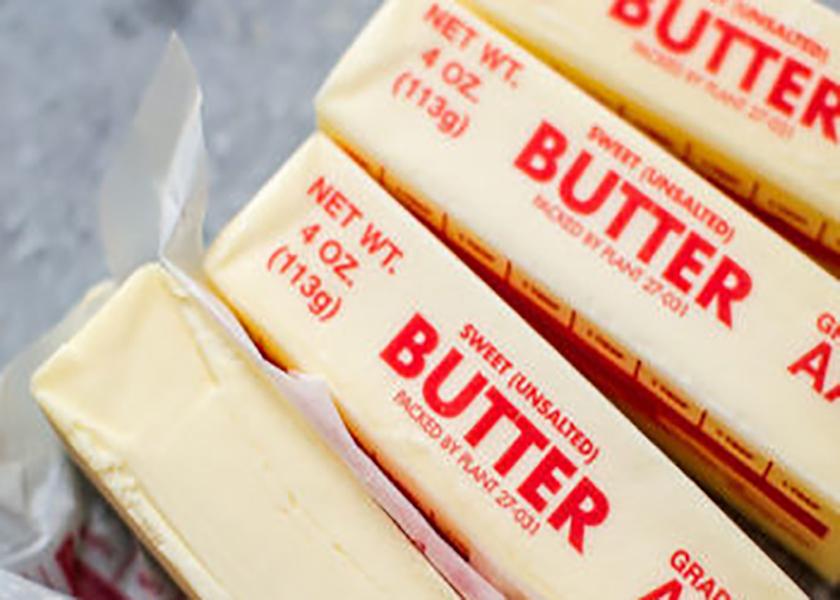How Long Will Butter Remain Rangebound?

Butter price certainly has been unexciting, lacking volatility since the beginning of the year. It is not the first time the butter price has remained locked in a sideways range for an extended period. Generally, price will trend one way or the other or show significant volatility. However, when supply and demand are closely aligned, there is little reason for price to move very much. Buyers and sellers then become comfortable taking care of business without fanfare. We have seen butter price remain in a price range from a low of $2.2675 to a high of $2.4650 since December 23, 2022. Churning has been active with supply readily available for demand. The last time the market remained in a range for an extended period was August 16, 2018, through May 10, 2019. Price ranged from a low of $2.19 to a high of $2.34 during that period (see charts). It is hard to believe that less than a year ago, there was concern over a butter shortage resulting in price moving to a new high before the industry and traders realized that was not going to be the case. Once the fear of a shortage evaporated. The market spent the next three months trying to find a bottom and once found, resulted in the current sideways pattern.
Not only do we see a balance of supply and demand in the domestic market, but slower international demand has also impacted the price. Butter exports have been strong for quite some time as world demand has been increasing with a large increase taking place during the past three years. However, strong export demand has run its course as world demand has declined. April butterfat exports were down 64.5% from April 2022. This has not been just a one-month aberration, but butterfat exports for the first five months of the year were down 41.9% compared with the same period in 2022. The sideways butter price is not just a reflection of domestic demand but also of international demand. The current trend and fundamentals may leave butter range bound for a longer period.
The sideways price range of butter has been able to hold Class IV prices and futures at a better level than Class III. Cheese prices have not been able to find the stability that butter has. Plentiful milk supply, strong cheese production, and plants not wanting inventory to build at the plant level continue to move cheese to the market. There is no interest in holding back supply for a seasonal increase as storage costs are higher and there is the question of whether a seasonal price increase will take place under the current market environment. Cheese exports are beginning to see a weaker pattern with exports in April down 11.7% from April 2022. This may be one reason plants would rather move supply. The cost of storing cheese may only be offset by the gain in price leaving plants just trading dollar for dollars rather than any financial gain.
It certainly is interesting times we are in, and it may not be much better next year if USDA’s estimates would come to fruition. They estimate the Class III milk price to average $16.70 this year and $17.00 next year. They estimate Class IV to average $18.35 this year and $17.45 next year. They estimate the All-milk price to average $19.85 this year and $19.65 next year. If this were to unfold as predicted, lower milk prices will be around for an extended period. However, with low milk prices such as we have now, milk output will be impacted as culling will increase significantly over time and supplies will eventually tighten. A repeat of last year is not likely, but higher prices could unfold.
Robin Schmahl is a commodity broker with AgDairy, the dairy division of John Stewart & Associates Inc. (JSA). JSA is a full-service commodity brokerage firm based out of St. Joseph, MO. Robin’s office is located in Elkhart Lake, Wisconsin. Robin may be reached at 877-256-3253 or through the website www.agdairy.com.
The thoughts expressed and the basic data from which they are drawn are believed to be reliable but cannot be guaranteed. Any opinions expressed herein are subject to change without notice. Hypothetical or simulated performance results have certain inherent limitations. Simulated results do not represent actual trading. Simulated trading programs are subject to the benefit of hindsight. No representation is being made that any account will or is likely to achieve profits or losses similar to those shown. There is risk of loss in trading commodity futures and options on futures. It may not be suitable for everyone. This material has been prepared by an employee or agent of JSA and is in the nature of a solicitation. By accepting this communication, you acknowledge and agree that you are not, and will not rely solely on this communication for making trading decisions.







